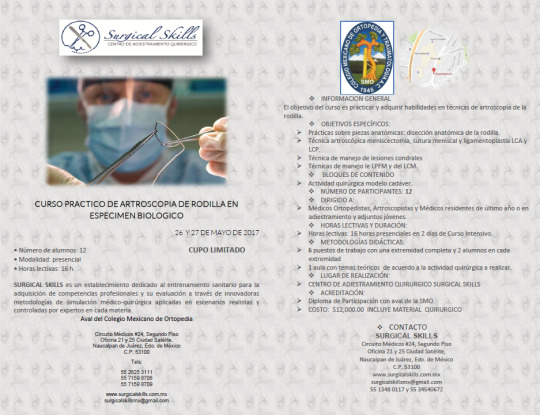| |||||||||||
martes, 23 de mayo de 2017
Ultrasonido pulmonar / Lung ultrasound
lunes, 22 de mayo de 2017
La valoración geriátrica integral previene el delirium tras una fractura de cadera: revisión sistemática de ensayos clínicos.

Fuente
Este artículo es originalmente publicado en:
Este artículo es originalmente publicado en:
© SEMEG. Todos los derechos reservados
Principios de Osteotomía y Corrección de Deformidad
Principles of Osteotomy and Deformity Correction
Fuente
Este artículo es originalmente publicado en:
Este artículo es originalmente publicado en:
De y todos los derechos reservados para:
Courtesy: Dr Sameer Qureshi,
Consultant Orthopaedic Surgeon
This video describes the basics of osteotomy that are essential for deciding the management of various deformities in the clinics and also important as a student’s point of view for exams and to understand the concept behind various osteotomies.
References – Principles of deformity correction: Dror Paley.
References – Principles of deformity correction: Dror Paley.
For more topics in Orthopaedics visit my facebook page at https://www.facebook.com/TheYoungOrth…
or visit my blog The Young Orthopod at http://youngorthopod.blogspot.in/
- Categoría
- Licencia
- Licencia de YouTube estándar
CURSO PRÁCTICO DE ARTROSCOPIA DE RODILLA EN ESPÉCIMEN BIOLÓGICO
próximo curso: 26-27 de mayo 2017
Inscríbete ya!!!
Surgical Skills
CENTRO DE ADIESTRAMIENTO QUIRÚRGICO
Circuito Médicos no. 24, 2° Piso, Oficina 21 y 25
Ciudad Satélite, Naucalpan de Juárez
Estado de México C.P. 53100
surgicalskillsmx@gmail.com
teléfonos: 5571598706 y 5571598709
sábado, 20 de mayo de 2017
CURSO PRÁCTICO DE ARTROSCOPIA DE RODILLA EN ESPÉCIMEN BIOLÓGICO
próximo curso: 26-27 de mayo 2017 Inscríbete ya!!!
Surgical Skills CENTRO DE ADIESTRAMIENTO QUIRÚRGICO
Circuito Médicos no. 24, 2° Piso, Oficina 21 y 25
Ciudad Satélite, Naucalpan de Juárez
Estado de México C.P. 53100
surgicalskillsmx@gmail.com teléfonos: 5571598706 y 5571598709




Conversión a Artroplastia Total de Hombro Reversa con y sin Retención del vastago Humeral: El Rol de un vastago de Plataforma Convertible.
Conversion to Reverse Total Shoulder Arthroplasty with and without Humeral Stem Retention: The Role of a Convertible-Platform Stem.
Fuente
Este artículo es originalmente publicado en:
Este artículo es originalmente publicado en:
De:
.
2017 May 3;99(9):736-742. doi: 10.2106/JBJS.16.00683.
Todos los derechos reservados para:
Copyright © 2016 Ovid Technologies, Inc., and its partners and affiliates. All Rights Reserved.
Some content from MEDLINE®/PubMed®, a database of the U.S. National Library of Medicine.
Abstract
BACKGROUND:
Revision shoulder arthroplasty is a technically challenging procedure. It is associated with increased blood loss and operative time, and it frequently necessitates revision implants, augments, and bone-grafting. Shoulder arthroplasty systems with a convertible-platform humeral stem have been developed to reduce the complexity of revision procedures by eliminating the need for humeral component explantation when converting from anatomic shoulder arthroplasty (hemiarthroplasty or total shoulderarthroplasty) to reverse total shoulder arthroplasty (rTSA).
CONCLUSIONS:
Shoulder arthroplasty systems that utilize a convertible-platform humeral stem offer an advantage for rTSA conversion in that a well-fixed, well-positioned humeral stem can be retained. There were significantly fewer complications as well as significantly decreased blood loss and operative time when a convertible-platform stem was utilized (p < 0.050).
LEVEL OF EVIDENCE:
Therapeutic Level III. See Instructions for Authors for a complete description of levels of evidence.
Resumen
ANTECEDENTES:
La artroplastia de hombro de revisión es un procedimiento técnicamente difícil. Se asocia con aumento de la pérdida de sangre y el tiempo quirúrgico, y con frecuencia requiere implantes de revisión, aumentos y injertos óseos. Se han desarrollado sistemas de artroplastia de hombro con un vástago humeral de plataforma convertible para reducir la complejidad de los procedimientos de revisión eliminando la necesidad de explanación de componente humeral al convertir la artroplastia anatómica de hombro (ARTHA).
CONCLUSIONES:
Los sistemas de artroplastia de hombro que utilizan un vástago humeral de plataforma convertible ofrecen una ventaja para la conversión rTSA en que se puede retener un vástago humeral bien fijado y bien posicionado. Hubo significativamente menos complicaciones, así como una disminución significativa de la pérdida de sangre y el tiempo de operación cuando se utilizó un vastago de la plataforma convertible (p <0,050).
NIVEL DE EVIDENCIA:
Nivel terapéutico III. Vea las Instrucciones para los Autores para una descripción completa de los niveles de evidencia.
PMID: 28463917 DOI:
Suscribirse a:
Entradas (Atom)




